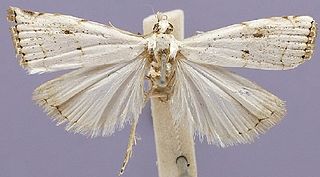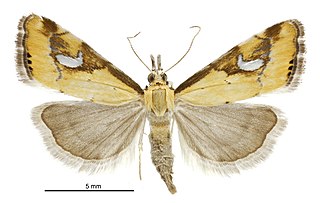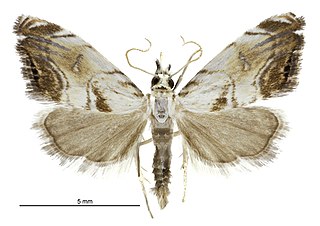
Diptychophora is a genus of moths of the Crambidae family.

Maoricrambus is a genus of moths of the family Crambidae. It contains only one species, Maoricrambus oncobolus, which is endemic to New Zealand. This species is classified as Nationally Endangered by the Department of Conservation.

The National Institute for Space Research is a research unit of the Brazilian Ministry of Science, Technology and Innovations, the main goals of which are fostering scientific research and technological applications and qualifying personnel in the fields of space and atmospheric sciences, space engineering, and space technology. While INPE is the civilian research center for aerospace activities, the Brazilian Air Force's General Command for Aerospace Technology is the military arm. INPE is located in the city of São José dos Campos, São Paulo.

Glaucocharis chrysochyta is a species of moth in the family Crambidae. This species was first described by Edward Meyrick in 1882. It is endemic to New Zealand and is found throughout the country. It inhabits native forest. Larvae appear to feed on moss and likely pupate there. Adult moths are on the wing from November to March. They fly at night and are attracted to light.

Catharylla bijuga is a moth of the family Crambidae described by Théo Léger and Bernard Landry in 2014. It occurs in lowlands of the Guianas and Brazil.

Catharylla chelicerata is a moth of the family Crambidae described by Théo Léger and Bernard Landry in 2014. It is found in French Guiana and Amazonas, Brazil.

Catharylla gigantea is a moth of the family Crambidae described by Théo Léger and Bernard Landry in 2014. It is found in French Guiana, Guyana and the Brazilian state of Amazonas.

Catharylla coronata is a moth of the family Crambidae described by Théo Léger and Bernard Landry in 2014. It is found in Brazil.

Catharylla mayrabonillae is a moth of the family Crambidae described by Théo Léger and Bernard Landry in 2014. It is found in Costa Rica, Panama, Colombia, Venezuela, the Guianas, Ecuador, Peru, and Brazil.

Catharylla serrabonita is a moth of the family Crambidae described by Théo Léger and Bernard Landry in 2014. It is found in the Brazilian states of Bahia and Espírito Santo.

Catharylla tenellus is a moth of the family Crambidae. It is found in the Atlantic Forest of Brazil in the states of Bahia, Minas Gerais, Paraná, Rio de Janeiro, and São Paulo.

Catharylla paulella is a moth of the family Crambidae described by William Schaus in 1922. It is found in Brazil and Bolivia.

Orocrambus abditus is a moth of the family Crambidae. It was first described by Alfred Philpott in 1924. It is endemic to New Zealand and can be found in Marlborough, Arthur's Pass, and in Canterbury. The species inhabits grassland including tussock grassland and shrubland. Larvae have been collected in October and the adults of this species are on the wing from October to March.

Glaucocharis bipunctella is a moth in the family Crambidae. It was described by Francis Walker in 1866. This species is endemic to New Zealand and has been found in the Auckland region, in the southern parts of the North Island and in the Nelson region. It inhabits dense native forest. Larvae of this species have been raised on liverworts. Adults are on the wing in November to January and are attracted to light.

Glaucocharis elaina is a species of moth in the family Crambidae. This species was described by Edward Meyrick in 1882. It is endemic to New Zealand and is found throughout the North and South Island with the exception of the extreme south of the South Island. The preferred habitat of this species is lowland native forest and as adults the species is attracted to broken ground including road or rail cuttings. Larvae feed on moss species including those in the genus Funaria. This species has two distinct broods during each year. Adults are on the wing from October to April, are nocturnal and are attracted to light.

Glaucocharis auriscriptella, also known as the yellow silverling, is a moth in the family Crambidae. It was first described by Francis Walker in 1864 and is endemic to New Zealand. This species can be found in the North, South, Stewart and Great Barrier Islands. The preferred habitat of this moth is lowland and subalpine native forest as well as wetlands. The larvae feed on moss. The adult moth is day flying and is on the wing from November to February. It can be observed in colonies and can be attracted to light at night. This species likely has only one generation per year.

Glaucocharis lepidella is a species of moth in the family Crambidae. It was described by Francis Walker in 1866. It is endemic to New Zealand and is found in both the North and South Island. The species inhabits lowland to subalpine native forest. Larvae may feed on mosses. Adults are on the wing from November to February and are attracted to light.

Glaucocharis epiphaea is a species of moth in the family Crambidae. It was described by Edward Meyrick in 1885. It is endemic to New Zealand and has been observed in both the North and South Islands. G. epiphaea prefers mountainous habitat and frequents very damp spots including alpine and subalpine moss bogs. Larvae feed on the moss Dawsonia superba. Adults are on the wing from September until March and are diurnal.

Glaucocharis harmonica is a moth in the family Crambidae. This species was described by Edward Meyrick in 1888. It is endemic to New Zealand and is found in the North and South Islands. It inhabits lowland to subalpine native forest. It has been hypothesised that there are two broods per year. The larval hosts are unknown. Adults are on the wing from October until January.

Ricardo Magnus Osório Galvão is a prominent Brazilian physicist and engineer, formerly the Director-General of the National Institute for Space Research. He is a full Professor of the Institute of Physics of the University of São Paulo, member of the Brazilian Academy of Sciences, fellow of the Institute of Physics and councilman of the European Physical Society. Galvão has occupied major positions within the Brazilian Physics community such as the presidency of the Brazilian Physical Society (2013–2016) and the directorship of the Brazilian Center for Research in Physics (2004–2011).
























